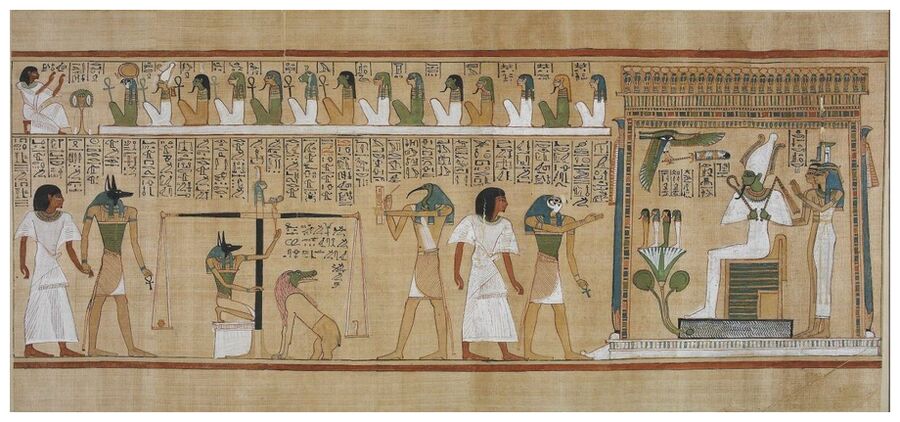
© The Book of the Dead of Hunefer, sheet 3.
A new natural technique for cleaning and preserving priceless ancient Egyptian papyrus that are in danger from bacteria and fungi has been discovered by researchers.
This new technique employs wasabi - yes, the pungent green paste accompanying your sushi - to combat the relentless threat of fungal damage on these precious historical documents.The study, led by Hanadi Saada and her team, investigated the effectiveness of
wasabi vapors in eliminating microbial growth that deteriorates papyrus artifacts, which have historical and cultural significance, particularly in ancient Egypt.
The techniques used up until now to clean and sanitize the papyri presented certain difficulties. Chemicals were employed that, while effectively eliminating microbes, sometimes damaged the papyrus fiber or altered the pigments of the illustrations. Other physical methods, such as ultraviolet rays or heat, did not always ensure the complete removal of biological agents without causing collateral damage. This is where wasabi comes into play.
The Grand Egyptian Museum's team has devised a 'green' solution that promises to protect these ancient texts without jeopardizing their integrity by generating vapors from wasabi paste.
Scientists simulated microbiological contamination on samples of papyrus with different pigments, including red, yellow, and blue.

© MIURA, Yuji/ CC BY-SA 4.0Wasabi in root and paste form usually served in sushi restaurants.
In this experiment, treatment with wasabi vapors for 72 hours eradicated microbial growth in both painted and non-painted papyrus samples with a 100% inhibition efficiency. Notably, the treatment improved the tensile strength of the papyri by 26% without causing any noticeable change to the color or surface morphology of the artifacts. Furthermore, FT-IR and EDX analyses indicated negligible chemical changes, underscoring the non-invasive nature of the treatment.
In addition to providing a safer, more environmentally friendly option for preserving archaeological papyri, this cutting-edge technique guarantees the longevity of these priceless relics without sacrificing their integrity. The results of the study point to a dramatic shift in favor of environmentally friendly conservation techniques and highlight the significance of sustainable methods for the preservation of cultural heritage and archaeology.
The results of this study could have an impact on preservation methods for a variety of organic archaeological materials, going beyond papyri conservation. The archaeological community is keeping a close eye on the research in the hopes that this environmentally friendly solution will usher in a new era for the preservation of our world's cultural heritage.
The study was published in the
Journal of Archaeological Science.


Reader Comments
~
BK
ps - what is the organic/solvent content in low viscosity epoxy I query? That reminds of the "epoxy putty" I got - I used that stuff on a tricky job!
I would say using an extraordinary thin layer of gold or platinum so think that is was essentially translucent....that might protect the old paper if applied properly - most likely under vacuum in a chamber designed to allow very, very small particulate and or mist to cover the old paper thinly for the sake of preservation of ancient wisdom or the lack thereof.
~
Peace!
Ken
And to keep the answers in one post ... Yes, sunlight (UV) might cause a yellowing.
But this is not a problem, these documents are kept locked up in a dark safe anyway. The same problem applies to paintings. They are also kept indoors, out of the sunlight.
That had been tried out. And even with relatively primitive means (hammers), you get to 1 um (micrometer) and below, and it still does not become translucent. [Link]
The only problem with the epoxy method is that it messes up later chemical or DNA analyses. But what the heck, the so-called "virus isolation" consists of throwing monkey tissue and bovine tissue into the mix with human cells.
So, let's call the epoxy soaking process "Codis' Papyrus Isolation". And I have it patented as such, and get filthy rich ...
~
versus ~
May the best idea prevail!
I mean one place I worked with was Kurz Hastings - that is a name from the past, but they have some fine printers in their arsenal.
I assume you have been to places with liquid baths and the oh so thin layer gets applied with electricity in the bath solution?
One place in Murphy, NC - now shutdown used to make screwdrivers there and that place was awesome - tis a shame it is shutdown, but I suspect the knowledge to get it back up and running is still around!
~
Name a type of factory you don't think I've been in - and I'll either refute you with a personal anecdote or admit you got me......but I've been to so many over the years and I know how to do a root cause analysis.
[Link]
Deposition can be accomplished in many ways, but in a vacuum where helium is the only gas present in minute amounts - a fine layer of film upon a surface could be applied for protective purpose.
~
Here is another link, but be aware hexavalent chromium is quite problematic - but tis just a state of the element ain't it?
[Link]
Just joking ...
All resemblance to actual events and affairs is purely coincidental